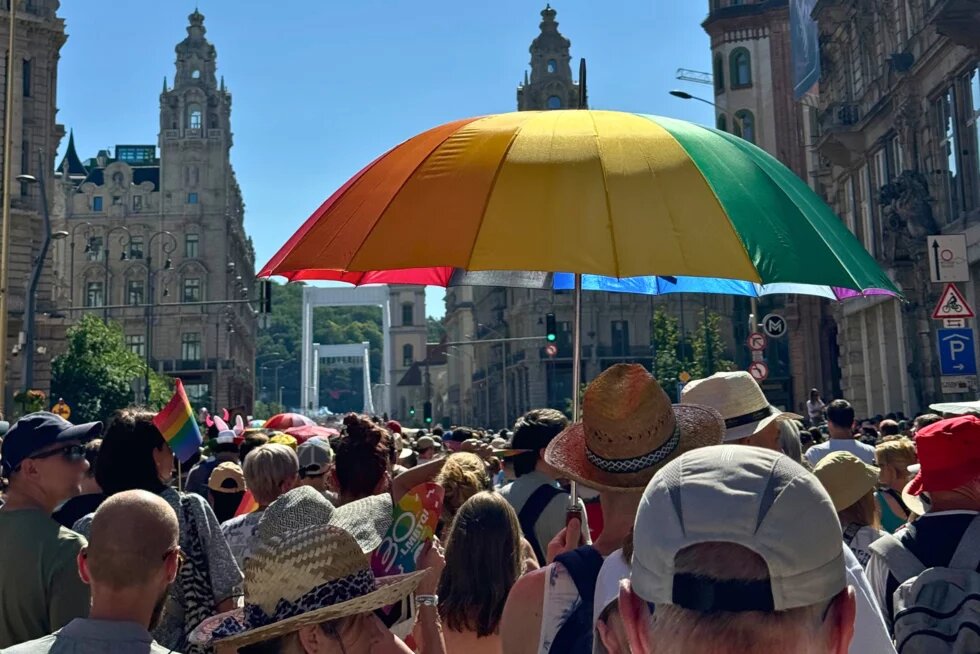Viktor Orbán scored a major “own goal” by banning Pride celebrations in Hungary, to summarize what happened in his political vocabulary, provoking Hungary’s biggest-ever Pride in Budapest, resulting in 200,000 participants and a strong sense of demanding political regime change in the country.

The massive, avenue-wide crowd, starting from Budapest’s Pest side at Deák Ferenc tér and marching across the Danube to the circular Móricz Zsigmond Square, stretching for three kilometres, was full of Pride participants on the sunny afternoon of 28 June 2025.
The huge turnout was fuelled by several key factors. The strongest was that part of the population who were triggered by the Fidesz government’s growing oppression when it comes to civil rights and freedoms. This freshly-booming support for the LGBTQI+ community in Hungary derives from the anti-government stance of the cautious, proactive groups in Hungarian civil society which, until the very recent appearance of the Tisza opposition party, did not have any real representation or voice. This drove the civil society groups to bring politics outside Parliament, where, since 2010, real public consultation and scrutiny have been almost entirely eradicated.
The pro-LGBTQI+ stance of the protesting Hungarians is quite real, but the overarching drive comes from the strong civil urge to change the government in 2026. It is important, therefore, to analyse what key moves led to Orbán taking this step that has backfired.
The pretexts for the decision to ban Pride were the numerous prior attempts of the Fidesz government since 2010 to oppress LGBTQI+ rights along the lines of Russia, Turkey, and other autocratic countries, citing family “protection” interests and children’s rights while curtailing the right to assembly and feeding anti-queer, anti-gay narratives and sentiments to the education system.
Then, at a Fidesz party meeting in spring 2025, Orbán told a loudly cheering crowd that he “advises the organisers of Pride not to bother with this year’s preparations, the government will ban them across the country”.
This speech was followed by the usual rushed-through passing of the ban on Pride in the form of an amendment to the Act on Child Protection. Throughout the spring, the weeks passed with Fidesz playing hardball. The Green, progressive Mayor of Budapest, Gergely Karácsony, took a politically very fruitful, strong, and visible position. He decided to stand firmly behind making the organisation of Pride go ahead and happen, despite continuous governmental attacks and attempts to halt the process. One legal attempt went all the way up the legal ladder to the Constitutional Court (Curia) which, to nobody’s surprise, upheld the ban. However, this did not stop Karácsony from going forward and making Fidesz government representatives, among them Justice Minister Bence Tuzson, threaten him with prison and tell the ambassadors of EU countries to Budapest that if they were to show up at the Pride venue, they would be breaking the law. This was paired with a massive communication campaign to threaten the general population with use of an AI-driven, Chinese CCTV recording system to be undertaken at the event, as well as spooking those who considered joining the march with fines of up to EUR 500 – all of this sugar-coated with “family values”- defending rhetoric and anti-LGBTQI+ statements.
Meanwhile, in Europe, civil society groups, EU bodies, and governments rang the alarm bell. On the 18 of June, the European Parliament passed a resolution urging solidarity with the LGBTIQ+ community, stating:
“Viktor Orbán, you cannot ban freedom, and you cannot ban love. Let’s send a strong message of solidarity…and support Budapest Pride on 28 June.”
In addition, 70 members of the European Parliament signalled their attendance at Budapest Pride.
In light of the Hungarian authorities’ threats to possibly use force against protesters, European Parliament Vice‑President Nicolae Ștefănuță called on the Hungarian Police to ensure participants’ protection. Ștefănuță’s statement reflected the authorities’ very real threat to deploy force as an option.
Furthermore, European Commission President Ursula von der Leyen, speaking at the June EU Summit in Brussels, explicitly called on Orbán to allow Budapest Pride while criticizing the ban. If that was not enough, in the European Council, 20 EU countries’ Foreign Ministers condemned Hungary’s anti‑LGBTQ+ laws — including the ban — and demanded either EU action against Hungary via rule‑of‑law mechanisms or the repeal of the ban. Coincidentally, the Commission published its annual Rule of Law Report at that same time, in which it was noted that Hungary’s civic space is deteriorating and the EU must remain vigilant. Governments of several EU Member States, including the foreign ministers of Austria and Belgium and the prime ministers of Spain and Sweden, bilaterally denounced the ban publicly, too.
Civil society followed suit with major supporting petitions such as the All Out petition, the WeMove Europe petition, and the International Lesbian, Gay, Bisexual, Trans and Intersex Association (ILGA-Europe) published a statement together with partner NGOs, while trade unions such as ETUCE have also expressed their solidarity with Pride.
Other bodies, like the Council of Europe’s Commissioner for Human Rights, human rights “watchdog” Michael O’Flaherty, called on Hungary to uphold the human rights of LGBTI people and to reverse clampdowns on civic space just days ahead of the event in the Hungarian capital.
Finally, Karácsony, despite all the government hurdles and legal challenges, went ahead with his Pride patronage and told authorities it was going to be an event hosted by City Hall, meaning the gathering itself and the venue, in his legal reading, did not require police approval. This resulted in Fidesz changing its rhetoric in the last few days prior to Pride, stating they would not use the authorities’ force against those attending. Besides the “usual” fake propaganda reporting and misleading material in the Hungarian public media’s news reports, no violence between the participants and the police or other forces took place whatsoever. AI CCTV camera systems, though, were placed at strategic points along the march route.
Ambassadors and representatives of 33 embassies from all over the world officially showed up at the Pride march along with EU commissioners, Members of the European Parliament and other public figures such as Greta Thunberg. In a broader sense, what happened at Budapest Pride is that a large number of freedom-loving citizens along with all of the pro-democratic civil society groups decided to stand behind the rainbow flag and seize the opportunity of major international attention to send a clear, loud message:
Hungary needs to end the Orbán regime and turn to a new page in its history in the EU, maintaining its democracy.
How did the government propaganda machine react? To frame this major political blow, they tried hard to spin the loss of face. First, pro-government outlets did their utmost to associate the emerging opposition Tisza Party with Pride and to corner its chair, Péter Magyar, into taking a Pride-supportive stance, which might divide the Hungarian electorate. This strategy failed, as Magyar abstained from explicitly, publicly sharing his approach or that of the newly-emerged opposition Tisza Party concerning Pride. Nevertheless, government representatives claimed after Pride that Magyar had “walked into their trap” and that the Tisza Party had associated itself with the LGBTQI+ community and with Pride.
Meanwhile, the reality could not have been more different. The international scandal generated by the Orbán government drove Pride as a subject onto the front pages of the BBC, The Guardian, The Washington Post, Politico and The New York Times, with several of them covering the event live. The EU further stiffened its backbone against the Hungarian government’s attempts to erode the rule of law, and its high representatives have been even more vocal about the need to end the democratic backsliding in Hungary. Never before had the European Council’s Article 7-based rule of law procedure enjoyed the support of so many Member States. Likewise, never before were so many heads of state expressing their concerns about the disloyalty of the Hungarian government to the EU, about the pro-Kremlin agenda Hungary pushes inside EU bodies, and about Hungary’s continuously-growing appetite for corruption and misconduct.
In this latest attempt to steer attention away from Hungary’s corruption, economic troubles, and political mismanagement, Orbán went for the good old “spread hatred, divide, and conquer” playbook – which, after years of systemically eroding civil liberties, reached the saturation point and massively backfired, resulting in his meticulously-executed “own goal”.


